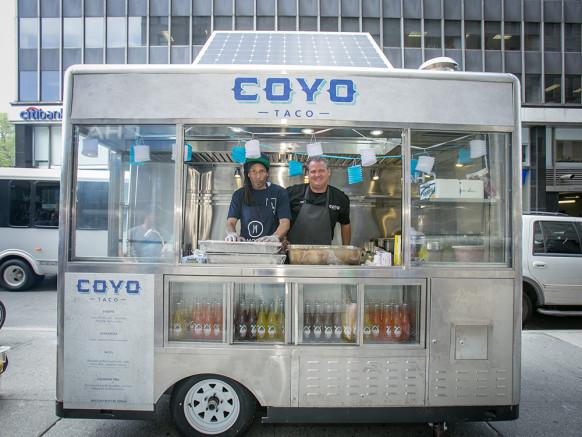There are 5,000 licensed food carts in New York, and they’re as much of an urban icon as the MTA’s subway signage or the Chrysler building. Too bad they’re killing the planet.
It’s not the food—the grub is OK, if not exactly slimming; it’s the gas generators powering the carts. Most food carts run off a diesel generator that’s designed to run only a few hours. Vendors run them for stretches of up to 14 hours, leading to a high output of greenhouse-gas emissions such as carbon monoxide, nitrous oxide, and particulate matter. You can see the smoke with the naked eye, but the hard facts are even more frightening: The research and consulting firm Energy Vision found that each cart produces the same amount of nitrous oxide as 186 cars on the road.
A new pilot program between the city and a Queens-based company called MOVE Systems aims to cut down on that pollution by at least 60 percent. For the past year, MOVE has been fine-tuning a new kind of food cart—called the MRV100—that’s powered by a mix of battery-generated electricity and solar energy, instead of dirty gas. The plan calls for getting a fleet of 500 new carts up and running by the summer of 2016, with the first 100 slated to roll out this summer.
The basic design of a food cart—distinguished from a food truck by its size and how easy it is to drive it, operate it, and park it—hasn’t seen much of an upgrade since the 1970s, when the city stopped issuing permits for new carts. (The scarcity of permits has spawned a black market that drives up the price for legit permits, similar to the illegal system of taxicab medallions.) Without new permits, there was little incentive to improve the kiosks. Plus, the EPA didn’t even outline emissions standards for generators until 2000.
For a 40-or-so-year-old design, the typical food cart is actually pretty sturdy and resilient. “The quality is surprisingly good,” says Michael Dubrovsky, a co-founder of Simply Grid, which merged with Mobile Vending Natural Gas a year ago to form MOVE Systems. It’s good enough that MOVE initially planned to retrofit existing food carts with products akin to electric vehicle chargers, rather than manufacturing an entirely new line of carts. Then they took a closer look under the hood to discover that none of these carts has the same design. “Each one is made artisanally in Queens and Brooklyn, at what we call chop shops,” Dubrovsky says. “Each one has different compartments, the plumbing is not up to code, so by the time you rip all that out, all of a sudden you’ve put liability on yourself.” So MOVE had to scrap the magpie carts and start from scratch.
The new MRV100 looks more like a compact, boxy Airstream than a rickshaw. It’s made of stainless steel, has rounded corners, and is about five feet wide by ten feet long. Besides the photovoltaic panels on the roof, the cart has a quieter hybrid compressed natural gas generator that charges an on-board battery, which can power the cart about half the time, giving the generator a break. MOVE plans to issue three different tiers of battery storage, so that a smoothie vendor running an energy-sucking blender can tap into more stored energy than one who’s flipping crêpes.
The MRV100 will also be equipped with small Internet-enabled computers featuring GPS and a range of sensors, including for fuel pressure and food temperature. At the moment, these monitoring stations will be used by the cart owners, rather than the vendors, to make sure things are running smoothly. Down the line, MOVE imagines that the new technology will provide information that vendors can use to tailor their menus and point-of-sale systems. And to preserve the quality of the carts for as long as possible, the chassis of the MRV100 is bolted, not welded, on. Because New York is a coastal city, the salt in the air can easily damage the metal on the trucks. Replacing the bottom on the older, welded-together models can cost thousands of dollars and take days; with the new ones, it’s a quick repair.
One hundred of the first carts will be funded by MOVE and reserved for disabled veterans, and the remaining 400 will go to vendors who sign up—at no cost to them, because the pilot program will be sponsored. (MOVE says they are still reviewing sponsors and advertisers and have yet to make a selection.) Vendors will still have to shoulder the costs of the compressed natural gas fuel (but not Internet connectivity), but Energy Vision’s report also suggests that running a food cart on grid power could save $5,200 a year in energy charges.
Overall, MOVE’s objective is to make the MRV100 feel more like a restaurant than a hot-dog stand. Besides the sheer fact that they’ll be shiny and new, the MRV100 carts will allow for hundreds of kitchen-equipment configurations (the MOVE guys imagine chef partnerships down the line) and make better use of bigger, transparent windows, so customers can see more of the food and how it’s being prepared—upping both their trust and the vendor’s pride in his preparation. “I can’t imagine serving gourmet quinoa out of the older carts,” Dubrosky says.
Also in Wired:
Cuba Has a Lung Cancer Vaccine—and America Wants It
You Should Google Everyone, Even Your Therapist
What Cities Would Look Like if Lit Only by the Stars
